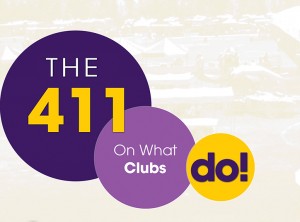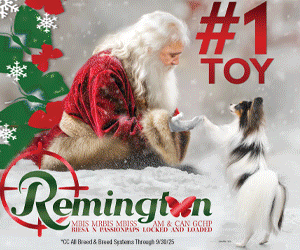The 411 On What Clubs Do!
Click here to read the complete article
By William Given
 At the heart of our sport are the all-breed kennel clubs and the local specialty (breed) clubs. And, there are the parent specialty clubs and a growing number of group clubs. There are also obedience training clubs and clubs for tracking, agility, lure coursing, herding, earthdogs, coonhounds, field trials and hunt tests. And, let us not forget the juniors’ clubs and the 4-H dog clubs. I found myself wondering, “just how many dog clubs are there here in the United States?”
At the heart of our sport are the all-breed kennel clubs and the local specialty (breed) clubs. And, there are the parent specialty clubs and a growing number of group clubs. There are also obedience training clubs and clubs for tracking, agility, lure coursing, herding, earthdogs, coonhounds, field trials and hunt tests. And, let us not forget the juniors’ clubs and the 4-H dog clubs. I found myself wondering, “just how many dog clubs are there here in the United States?”
When you have a question of that nature, the best place to go for the answer is the American Kennel Club. At the present time, 4,890 clubs are eligible to conduct events under the AKC’s rules and regulations. But, the AKC is not the only organization which have clubs holding canine competitive and titling events. So, I find it quite possible that number could easily be double. If it is, and if each club does just one event per month for the benefit of the general public or the fancy, that adds up to 117,360 positive outcome opportunities for the sport.
Breed Loyalties
Breed loyalty has to be one of our sport’s great phenomena. The American Kennel Club recognizes 189 breeds. The Federation Cynologique Internationale officially recognizes 332 breeds, and there are literally hundreds more breeds found around the globe. Somehow it just does not seem logical that we as individuals could select and dedicate ourselves to the perfection and promotion of just one breed. However, that is exactly what the vast majority of us do. Having such a strong breed loyalty is, I believe, healthy and even necessary for the continued growth of our sport.
Most specialty clubs provide notable public services in their efforts to promote their breed. Some clubs publish and produce informational brochures and pamphlets for member breeders to distribute, one with each puppy sold when he goes to his new home. Some clubs have volunteer mentors, who are available for consultation and assistance to novice exhibitors and first-time breeders. All clubs stand to gain alot by offering prospective owners and novices accurate information and hard-learned advice.
Public Service Contributions
Without question, the most common public service rendered by clubs is the presentation of dog shows and trials. Most dog show enthusiasts would be inclined to comment, “Well, that is what kennel clubs are supposed to do.” And yes, that is true, but dog shows have repeatedly shown that they stimulate the public’s interest in purebred dogs. They offer a showcase where the public can meet the breeds, see up close and get hands-on with the breed with which they have a particular affinity or attraction. It is at these events that people can make real progress toward selecting the breed of canine companion with which they will eventually be most satisfied. It is at dog shows and trials that the public can see dogs of much better than average quality and they can observe dogs with the ability to do the job for which they were originally bred. Furthermore, dog shows and trials provide excellent opportunities for selecting breeding stock. Without them, the heritage of the sport of purebred dogs would wain and vanish.
Another public service commonly provided by dog clubs is the hosting of educational programs and the offering of guest speakers. Knowledgeable and experienced breed enthusiasts can bring new information and new perspectives to all those who are seeking to learn more about their chosen breed or other topics about dogs in general. Certainly, the greatest number of educational programs center around breed seminars meant to promote more consistent judging, but exhibitors can find them particularly informative also. Including topics such as breeding, conditioning, and grooming and exhibiting in breed presentations will make things a little easier for newcomers. More advertising and better marketing could dramatically increase attendance by the general public at these events. Quality educational programs, combined with a friendly membership and motivated club leadership, go a long way to attract new members and retain the members that have been around for a while.
All of us who really enjoy judging junior showmanship cannot help but notice that some young people are more advanced in their handling skills than other juniors. In some parts of the country, juniors judges will commonly observe that a larger portion of the junior competitors possess greater skills. It should come as no surprise that in these areas, the kennel clubs have a greater commitment to the youth and their place in our sport. These clubs have special programs for juniors and club volunteers teach the children that patience, compassion, expectations and sportsmanship are necessary elements for success in the juniors ring and in life. Young people learn to appreciate the joy of achievement that comes with hard work.
As a public service, a good many National Specialty clubs as well as some local breed clubs advertise and operate a breeder referral service for the benefit of prospective puppy purchasers. Clubs offering this service have discovered that if they can assist in guiding a buyer to the right breeder with the right puppy, they may have recruited a good prospective member in the process.
A wonderful public service, once common and often taken for granted, was the offering of obedience training classes. There is a saying frequently seen on the bumper stickers of the cars at dog shows, “A good dog has a title at both ends of his name.” There is certainly a great deal of truth in that adage. It is sad to say, but where clubs have lapsed, the big box pet supply retailers have seized the opportunity and scored big by offering training classes leading to the AKC’s Canine Good Citizenship testing and title.
Conformation training classes are a public service that was once as common as obedience classes. They were generally held once a week or bi-weekly. This service is one of the greatest forms of assistance that clubs can provide exhibitors. It is at conformation training classes that novice exhibitors can get a fair amount of one-on-one assistance from someone far more experienced and this help can put them in the ribbons much earlier in their show career. It seems reasonable to believe that if more clubs held conformation training classes, more clubs would have more members.
The importance of dog clubs in emergency situations is very often overshadowed by national humane organizations. Dog clubs and the breed rescue groups they support do more, and act sooner in the aftermath of natural disasters like hurricanes and tornadoes than any of them. Municipal animal shelters would simply be overwhelmed without the rapid response of dog clubs. The efforts of club members at times like this saves the lives of hundreds of dogs annually.
Diversified Efforts
• A number of national and regional clubs have produced and marketed video tapes and CDs to promote their breeds, or their shows.
• There are hundreds of clubs that designate, in their premium list, various charities as the beneficiaries of a portion of the proceeds from their shows and matches.
• Many others bleed their own treasuries to support the good work of human agencies and local municipal shelters.
• Still, other clubs choose to assist financially in the efforts of veterinary research or establish scholarships for worthy and needy students at schools of veterinary medicine.
• My heartfelt appreciation really goes to those clubs that offer scholarships and accept requests for grants from junior handlers to help them in their post-secondary educational efforts, regardless of the field of study. This money really does find a way of coming home to our wonderful sport.
I am sure it comes as no surprise to anyone that club members work with greater enthusiasm and determination when they know that their labors are benefiting a worthwhile cause. Working for a cause gives members a feeling of pride, in their work and in their club.
When a club’s treasury is allowed to grow beyond need, the membership tends to become reluctant to work with the kind of zeal which need provokes. I have also observed that when a treasury is kept at the minimum necessary to meet its financial obligations, there is no prize over which conflict and controversy might develop.
Club Publications
Dog clubs have for many years published and circulated publications in almost every conceivable form. The information contained in these publications is partially responsible for the early and continued success of our sport. They are of vital importance to national and regional clubs that have only quarterly or annual meetings. These publications also mean a great deal to the many members who do not live within easy commuting distance and cannot attend the meetings. Clubs need these publications to keep everyone informed and, in a sense, help bind the members together.
Club publications seem to be produced on every possible schedule, except daily. Some are published irregularly, when the volunteer editor can steal time away from their many other duties and responsibilities demanded by work and families. Some take on the simple newsletter format and the editors are granted a very modest budget with which to work. Other more financially prosperous clubs put out an impressive professional publication with informative articles and quality advertising that travel with the United States Postal Service via second-class mail. It does not matter if it is monthly or annual, photocopied or professionally laid out, each and every issues provides essential information and fosters communication within a club. Club publications are another service for the dog show fancy.
Our dogs perform such a wide variety of services for us. So many so, that the task of listing them would be great. The services that dog clubs render for their membership, for other clubs and organizations, and for the general public is equally numerous and diversified.
Short URL: http://caninechronicle.com/?p=97612
Comments are closed











